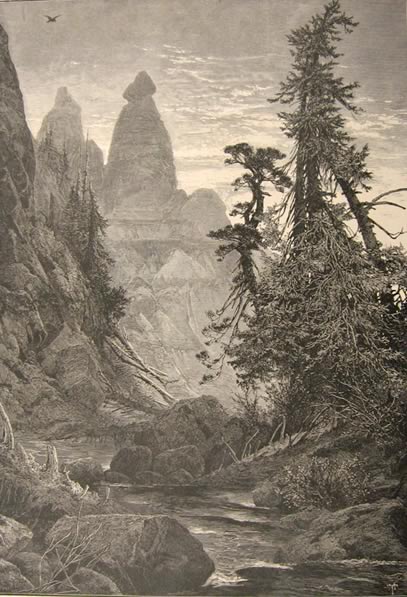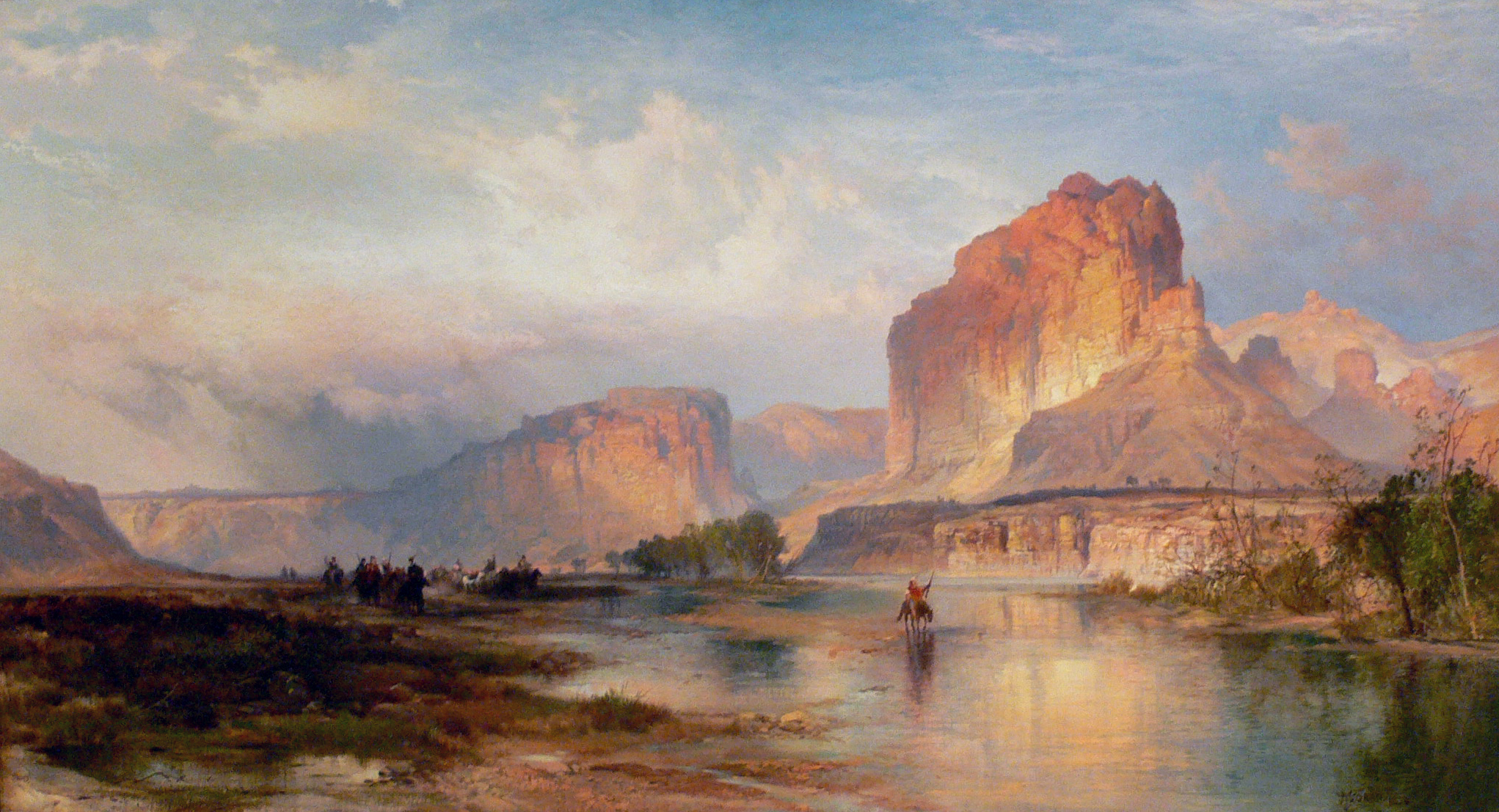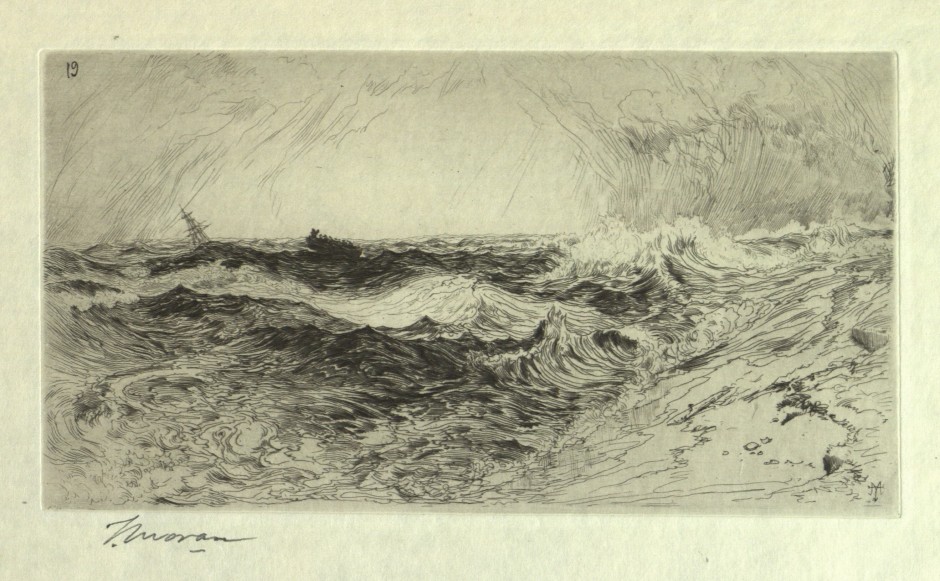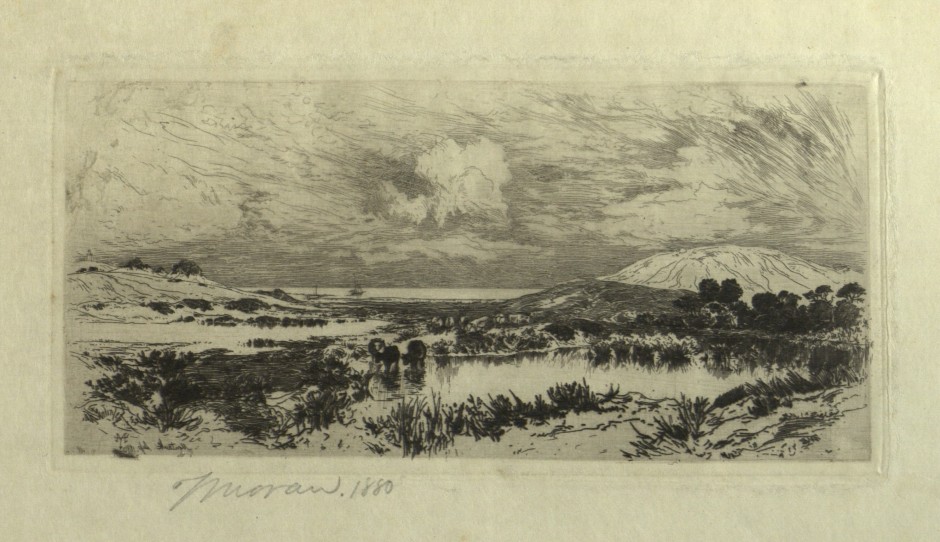Today we'll going to begin looking at a family of etchers that will take us through the end of the year: the Morans. Originally from England, the Morans came to the United States during the mid-nineteenth century, when industrialization essentially put an end to their livelihood as hand loomers. Several of the siblings achieved artistic success, usually within the genre of landscape, but the best known of this group is the artist we'll be discussing today, Thomas Moran (1837-1926).
Moran started out his artistic career apprenticing to Scattergood and Telfer, a wood engraving firm. During the 19th century, before photography had sufficiently evolved to become economically feasible, wood engraving was the most commonly used form of image reproduction. It provided the precision and detail of traditional metal engraving, but the use of wooden blocks made it a lot cheaper. Moran admittedly wasn't a fan of the process though, as engraving can be very time-consuming and repetitive, so he started working on his own watercolors on the side. Eventually he was able to draw the firm's designs, leaving the actual carving to other workers.
During the 1850s he studied painting with James Hamilton, and it was through Hamilton that Moran became acquainted with the work of J.M.W. Turner. The British painter would greatly influence the young artist, particularly in his use of color and sweeping compositions.
Moran is best known today for his grandiose Western images, particularly of Yellowstone and the Grand Canyon. In 1871, Moran accompanied Dr. Ferdinand Hayden, who the director of the United States Geological Survey, on an expedition to document the geoscapes of the West. His majestic, overwhelming vision of the West, with its unique rock formations and intense palette, would help inspire Congress to designate Yellowstone as a national park. The Grand Canyon and Yellowstone weren't the tourist vacuums we know today, so for most people back East, Moran's paintings were their introduction to these places. Needless to say, it was important for Moran to make a good impression, which he most certainly did. Replete with detail and color, his paintings are still impressive today.
Of course, the West wasn't the only place he visited. Moran traveled extensively during his lifetime, and sketched what he saw, as is the case with this Venice watercolor.
In addition to painting, however, Moran was also an accomplished etcher, along with his wife, Mary Nimmo Moran, a printmaker you'll get to know next month. Like his paintings, Moran's etchings are rich with detail, but they also have a somewhat looser, more gestural feel to them. During the second half of the nineteenth century, artists embraced etching for its similarities to drawing, and the spontaneity it could bring. Moran's etchings are still pretty detailed and precise as far as prints go, but you can still detect a looser, drawing-like quality, with the artist describing clouds, rocks, and other natural forms with confident, assured lines. They're especially evident in the skies, so be sure to look above the horizon when you're perusing these images.
Want to learn more? Here are some sites for you:
 |
| Image courtesy of: http://www.museumsyndicate.com/images/artists/543.jpg |
During the 1850s he studied painting with James Hamilton, and it was through Hamilton that Moran became acquainted with the work of J.M.W. Turner. The British painter would greatly influence the young artist, particularly in his use of color and sweeping compositions.
 |
| Tower Creek Below the First Falls, 1873. Originally published in The Aldine. Image courtesy of http://www.atticpaper.com/proddetail.php?prod=antique-print-tower-creek |
Moran is best known today for his grandiose Western images, particularly of Yellowstone and the Grand Canyon. In 1871, Moran accompanied Dr. Ferdinand Hayden, who the director of the United States Geological Survey, on an expedition to document the geoscapes of the West. His majestic, overwhelming vision of the West, with its unique rock formations and intense palette, would help inspire Congress to designate Yellowstone as a national park. The Grand Canyon and Yellowstone weren't the tourist vacuums we know today, so for most people back East, Moran's paintings were their introduction to these places. Needless to say, it was important for Moran to make a good impression, which he most certainly did. Replete with detail and color, his paintings are still impressive today.
 |
| Cliffs of Green River, 1874. Image courtesy of https://commons.wikimedia.org/wiki/File:Thomas_Moran_Cliffs_of_Green_River_Amon_Carter_Museum.jpg |
 |
| The Grand Canyon of the Yellowstone, 1872. Image courtesy of https://arthistory327.wordpress.com/2012/11/19/yellowstone-and-moran/ |
 |
| Hot Springs of Gardiner's River, 1872. Image courtesy of http://paintwatercolorcreate.blogspot.com/2012/10/featured-artist-thomas-moran.html |
Of course, the West wasn't the only place he visited. Moran traveled extensively during his lifetime, and sketched what he saw, as is the case with this Venice watercolor.
 |
| View of Venice, 1888. Image courtesy of https://commons.wikimedia.org/wiki/File:View_of_Venice_1888_Thomas_Moran.jpg |
In addition to painting, however, Moran was also an accomplished etcher, along with his wife, Mary Nimmo Moran, a printmaker you'll get to know next month. Like his paintings, Moran's etchings are rich with detail, but they also have a somewhat looser, more gestural feel to them. During the second half of the nineteenth century, artists embraced etching for its similarities to drawing, and the spontaneity it could bring. Moran's etchings are still pretty detailed and precise as far as prints go, but you can still detect a looser, drawing-like quality, with the artist describing clouds, rocks, and other natural forms with confident, assured lines. They're especially evident in the skies, so be sure to look above the horizon when you're perusing these images.
 |
| The Rescuing Party. Image courtesy of http://www.aaqeastend.com/contents/thomas-mary-morans-local-etchings-sketches/ |
 |
| The Pass of Glencoe, Scotland, 1883. Image courtesy of http://www.affordableart101.com/Thomas-Moran-Etchings-s/2104.htm |
 |
| The Half-Dome, Image courtesy of http://www.common-place.org/vol-07/no-03/rainey/ |
 |
| Montauk Ponds, 1880. Image courtesy of: http://www.aaqeastend.com/wp-content/uploads/2013/12/TMBAC-Print-Box-1-Etching-20_Montauk-Ponds-by-Thomas-M-940x542.jpg
I've seen Moran's etchings in every museum I've worked at, and they're always a treat to see. His work has definitely shaped how we view and imagine the West, and for that, his presence will always be part of our visual consciousness, even if we're not entirely aware of it.
|
Want to learn more? Here are some sites for you:
http://www.thomas-moran.org/biography.html
https://arthistory327.wordpress.com/2012/11/19/yellowstone-and-moran/
http://www.nga.gov/feature/moran/
https://arthistory327.wordpress.com/2012/11/19/yellowstone-and-moran/
http://www.nga.gov/feature/moran/
The 1873 Hayden Expedition into the West also was the defining experience for notable botanist John Merle Coulter, president of Lake Forest College, 1893-96. He then went to the new U. of Chicago as head of botany with his own new building.
ReplyDeleteWhat a great connection back to Lake Forest and Chicago! For those who may not know this, Lake Forest College is my alma mater, and Art Miller is the archivist emeritus of its fantastic Special Collections and historian extraordinaire. If you're in the area and want to see some wonderful primary materials (I worked there as a student, so I would know), you should definitely check it out. Thanks for sharing!
ReplyDelete